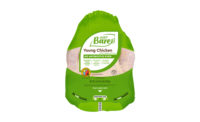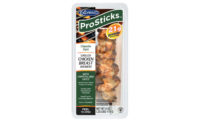Petite Hams Pack a Punch
by Bryan Salvage
Senior Editor
Senior Editor
Smaller products are designed for on-the-go families.
For millions of Americans throughout the country, nothing tastes better than a baked whole ham for dinner. And for an increasing number of households, the better hams suiting their needs aren’t necessarily the bigger ones — and savvy processors and processing equipment suppliers have taken notice of this trend.
During the 2003 International Dairy-Deli-Bake show in Las Vegas, several processors exhibited smaller whole-muscle ham products. Maple Leaf Foods, Fair Oaks, CA, planned to roll out a small 2-to-2 1/2 pound boneless spiral sliced ham before the summer’s end. A company spokesman explained that his company sees opportunity in offering smaller ham products.
“We will merchandise this product like a rotisserie chicken,” a company rep said. “It will be under ten dollars.”
He was confident this product would be a hit. Why?
“A lot of processors don’t want to process smaller hams,” he said with a grin.
He was confident this product would be a hit. Why?
“A lot of processors don’t want to process smaller hams,” he said with a grin.
Smaller hams are not new, and neither are rotisserie, fresh-leg products, points out Becca Hendricks, strategic marketing manager, the National Pork Board (NPB).
“But [small hams provide] a great opportunity to get ham muscles moved through retail outlets since there usually is surplus,” she adds. “And processors are always looking to respond to consumer trends for smaller portions [instead of buying one big ham].”
“But [small hams provide] a great opportunity to get ham muscles moved through retail outlets since there usually is surplus,” she adds. “And processors are always looking to respond to consumer trends for smaller portions [instead of buying one big ham].”
“Look at any retail meat case today and you’ll see what consumers are after: pre-packaged, convenient, and readily available products,” says Peter Ludwig, president of technology provider Wolf-tec Inc., Kingston, NY. “Delivering a high-quality ham that is sized for a family on the go has got to be a hit.”
Omaha, NE-based Omaha Steaks is another company offering small hams. It sells a 2-pound hardwood-smoked, boneless ham through its direct mail marketing channels and its Omaha Steaks retail stores. The only other ham it offers is a 7-pound spiral-sliced ham.
“Both of these hams [processed by contract packers] sell very well,” says Beth Weiss, Omaha Steaks public relations manager. “The two-pound hams sell for twenty-nine dollars each, and the seven-pound spiral-sliced hams sell for sixty-four dollars.”
Omaha Steaks has offered small 2-pound hams for the past several years, and this product has served equally as well as a premium.
Omaha Steaks has offered small 2-pound hams for the past several years, and this product has served equally as well as a premium.
“Twice a year, at Easter and again in November, we offer a two-pound ham free of charge with the purchase of thirty-five dollars or more of selected Omaha Steaks products,” Weiss says. “This promotion has been highly successful for us and exceptionally popular with our customers. After people try these hams and appreciate the convenience of a small ham, they often come back to purchase one.
“We think that the popularity of smaller hams is based on the fact that they serve as a quick and easy dinner solution for the family,” she adds. “Since the hams are fully cooked, it’s simple to just heat and serve, and the great traditional taste of ham makes it a family favorite.”
When asked who buys her company’s smaller hams, she answers that ham seems to be popular with all ages of customers.
When asked who buys her company’s smaller hams, she answers that ham seems to be popular with all ages of customers.
“We think the convenience of preparation and the great ‘one family meal’ size of the small hams are the reasons for their popularity,” she adds. “We plan to continue to offer them to customers through all our marketing channels.”
Technology addressing demand
Equipment technology suppliers also see an increase in demand for smaller hams, and this is reflected through their product offerings and service.
“We’ve seen a major increase in ham volumes of all sizes in the last three-to-four quarters,” Ludwig says. “Our customers are looking to meet the needs of consumers who are always on the go. Today this means adding a high-quality product in a convenient size to their product line.”
“We’ve seen a major increase in ham volumes of all sizes in the last three-to-four quarters,” Ludwig says. “Our customers are looking to meet the needs of consumers who are always on the go. Today this means adding a high-quality product in a convenient size to their product line.”
Manufacturing smaller hams, however, does have its share of challenges. Maintaining a whole-muscle product becomes a greater challenge with a smaller product, Ludwig says.
“It is essential that the manufacturing process create a very pliable muscle for packaging,” he adds. “Many processors are forced to ‘hold’ products for several hours or even days to make a better, more uniform product.”
“It is essential that the manufacturing process create a very pliable muscle for packaging,” he adds. “Many processors are forced to ‘hold’ products for several hours or even days to make a better, more uniform product.”
This holding period, however, stiffens the muscles and causes problems with stuffing and product forming, Ludwig continues. Chemical breakdown may also occur, leading to a deterioration of functional ingredients, reduced yields, and purge.
Wolf-tec’s POLAR Massager with Temperature Guidance allows processors to massage the product and go directly into stuffing, forming, and on to thermal treatment.
Wolf-tec’s POLAR Massager with Temperature Guidance allows processors to massage the product and go directly into stuffing, forming, and on to thermal treatment.
“This guarantees total ingredient functionality, maximized water binding, and a fully flexible, pliable product,” Ludwig says. “Temperature Guidance maximizes color and protein without the need for holding product.”
The small-ham niche demands top product quality.
The small-ham niche demands top product quality.
“Wolf-tec’s POLAR Massager coupled with our process application specialist provides the equipment and professional services to meet those demands,” Ludwig says. “In the last twelve months, our customers have declared our patented Temperature Guidance process as revolutionary in regard to ham processing. Our POLAR technology studies have shown superior color uniformity, a tighter bind, and improved texture, in a much shorter process time.”
These qualities present a better product to the consumer and enhance shelf stability by reducing product purge, Ludwig points out.
“Our studies have shown higher product yields in both cooking and slicing,” he adds. “The POLAR Massager will also reduce time to market. Massaging a ham at optimum temperatures, the cutting process that took forty-eight hours can be reduced to four or five.”
“Our studies have shown higher product yields in both cooking and slicing,” he adds. “The POLAR Massager will also reduce time to market. Massaging a ham at optimum temperatures, the cutting process that took forty-eight hours can be reduced to four or five.”
The Poly-Clip solution
Poly-Clip System Corp., Mundelein, IL, is also witnessing a huge increase in smaller hams, says Gil Williams, sales manager.
“I cannot say which customers are up and running with this product type, but we have a new process that has helped them to automate the process and increase production by five-hundred percent,” he adds.
“I cannot say which customers are up and running with this product type, but we have a new process that has helped them to automate the process and increase production by five-hundred percent,” he adds.
The major challenge of processing small hams is they are typically hand made at the rate of approximately seven-to-eight pieces a minute — making this process very labor intensive, he points out.
“We have introduced a new system [the Poly-clip ICA8700] that automates the entire process,” Williams says. “We introduced this new system at the last American Meat Institute show, and it is now a proven success with several systems installed and running.” Williams says the company collaborated with ViscoFan and Naturine and introduced the Poly-clip ICA 8700 in combination with the ViscoFan VN202 for high-speed production of boneless hams made in coffi and netting.
“We have introduced a new system [the Poly-clip ICA8700] that automates the entire process,” Williams says. “We introduced this new system at the last American Meat Institute show, and it is now a proven success with several systems installed and running.” Williams says the company collaborated with ViscoFan and Naturine and introduced the Poly-clip ICA 8700 in combination with the ViscoFan VN202 for high-speed production of boneless hams made in coffi and netting.
Used in combination with a large vein stuffer, the meat is stuffed through the VN202 where coffi and netting are applied and into the Poly-clip ICA 8700 automatic double clipper.
“The design of the new Iris separating system has given us the ability to gently separate and clip the delicate coffi film without damage to the film,” he says. “The system produces approximately thirty-five of the two-and-a-half pound hams per minute.”
“The design of the new Iris separating system has given us the ability to gently separate and clip the delicate coffi film without damage to the film,” he says. “The system produces approximately thirty-five of the two-and-a-half pound hams per minute.”
Looking Ahead
Demand for smaller hams will continue increasing primarily for one reason, sources say.
“It is more convenient for a family to prepare a one meal-sized portion,” Williams says. “Typically, the larger hams are for bigger groups during the holidays or special celebrations. These [larger hams] are simply too big for one meal.”
“It is more convenient for a family to prepare a one meal-sized portion,” Williams says. “Typically, the larger hams are for bigger groups during the holidays or special celebrations. These [larger hams] are simply too big for one meal.”
Technology suppliers participating in this article include:
-Poly-Clip System Corp., phone (847) 949-2800 or (800) USA-CLIP, fax (847) 949-2815, e-mail contact@polyclip-usa.com, or visit www.polyclip.com
-Wolf-tec Inc., phone (845) 340-9727 or (800) 257-4627, fax (845) 340-9732, e-mail sales@wolf-tec.com, or visit www.wolf-tec.com





Report Abusive Comment